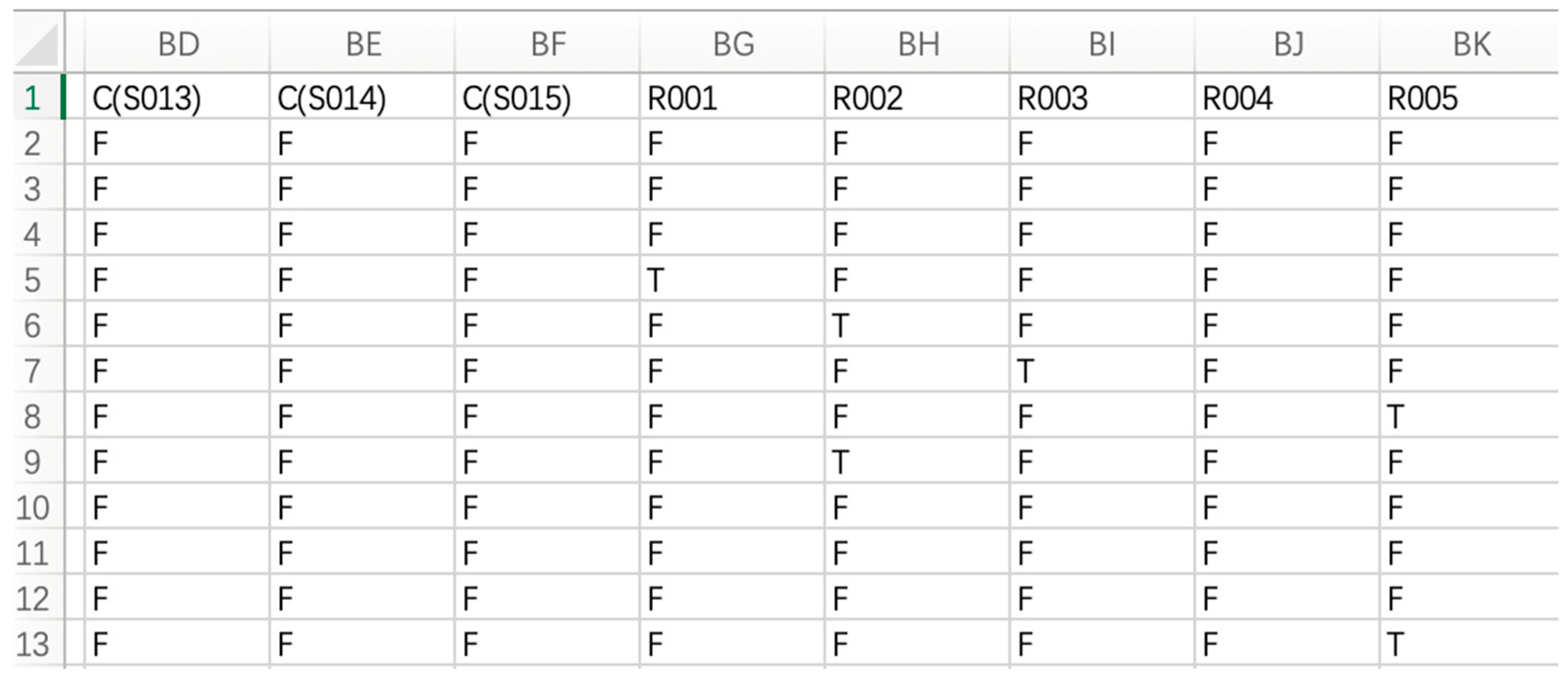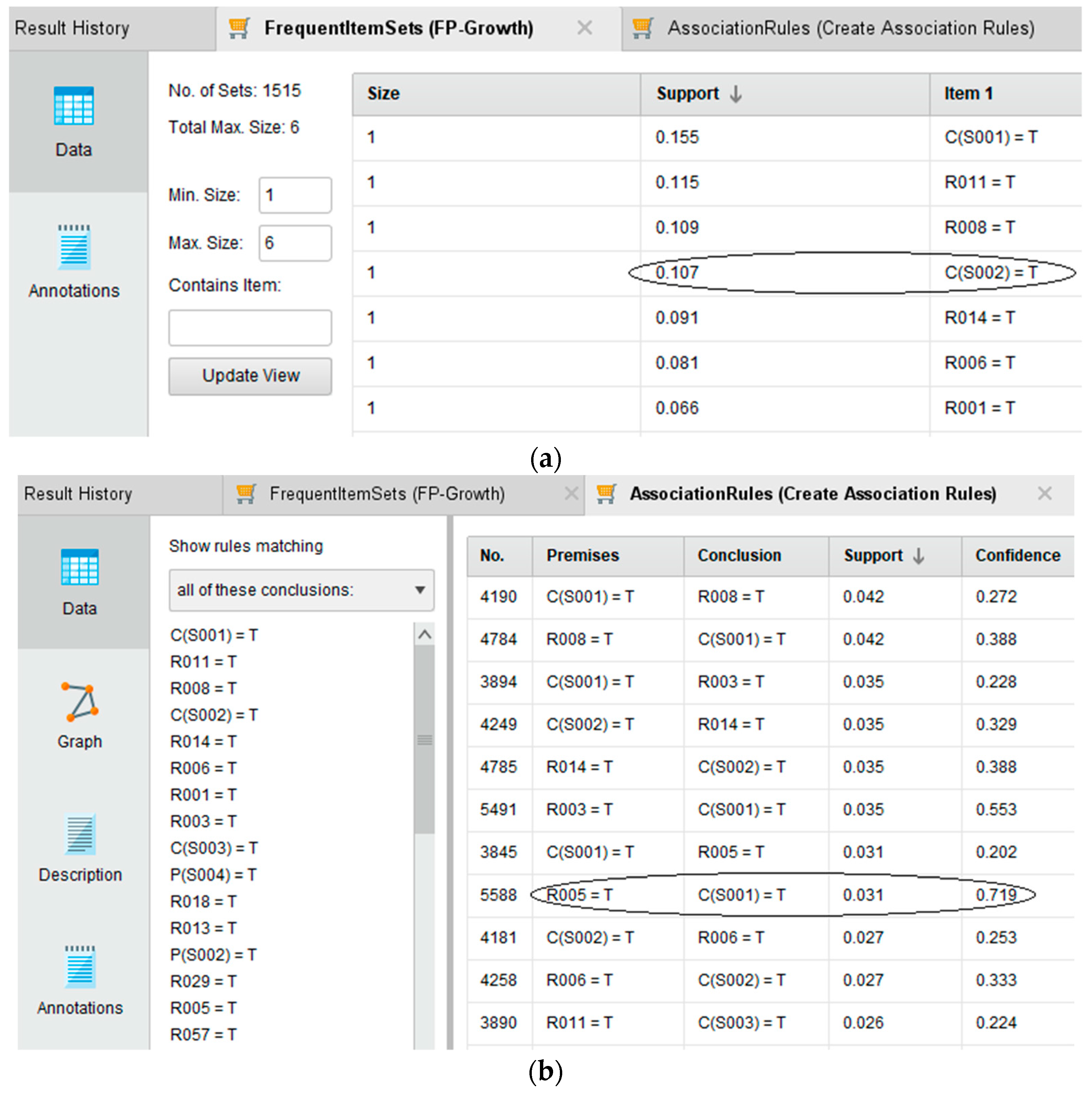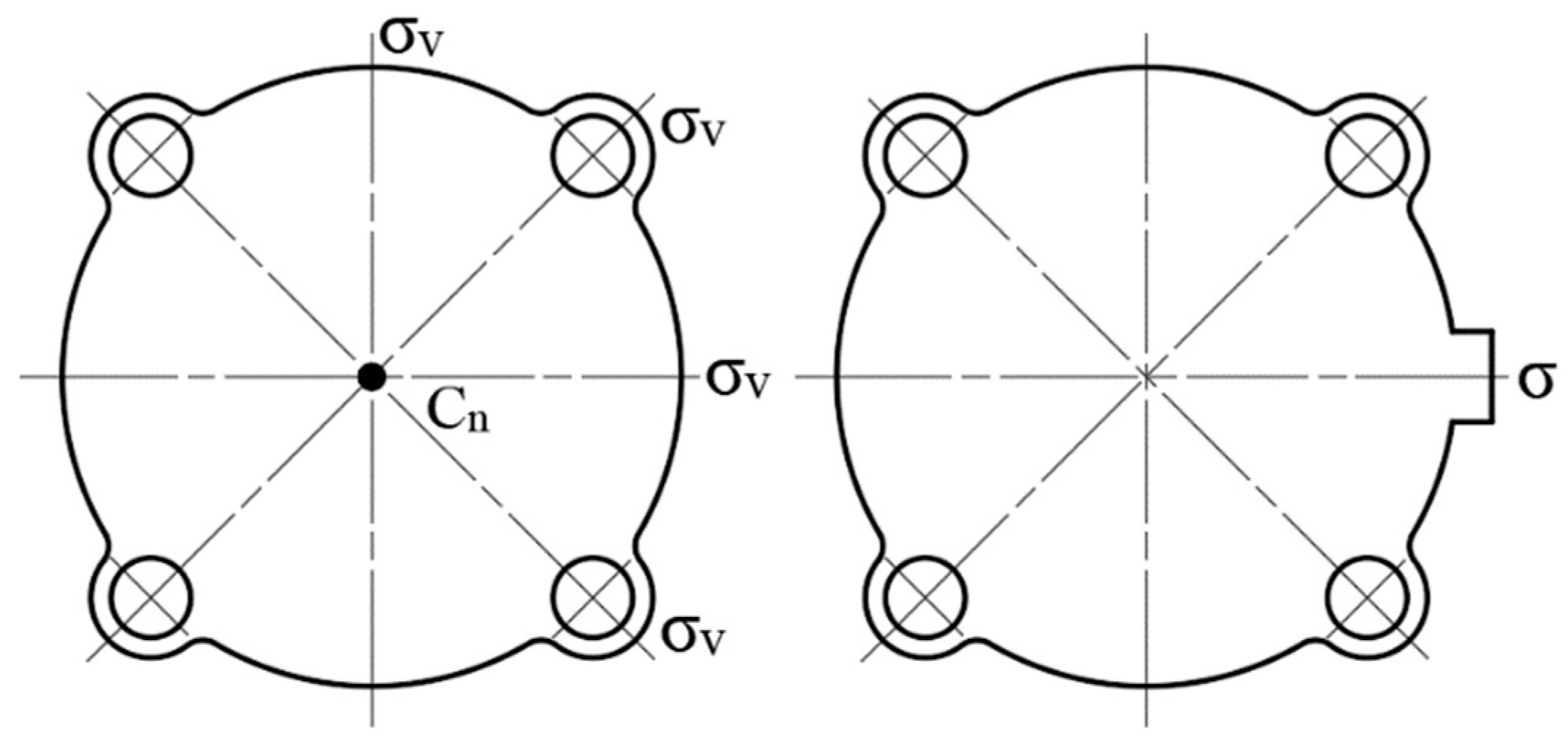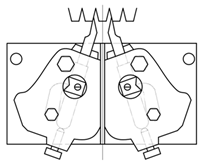Association Analysis between Mechanical Symmetry and Requirements
Abstract
:1. Introduction
2. Association Rule Mining
2.1. RapidMiner
2.2. Data Preprocessing
2.2.1. Case Analysis
2.2.2. Data Conversion
2.3. Modeling
Operators Used in the Model:
3. Mining Results
3.1. Main Parameters
3.2. Association Rules
3.2.1. Single Requirement
3.2.2. Multiple Requirements
- (1)
- Select a common symmetry scheme
- (2)
- Select a symmetry scheme for combination
3.2.3. Single Requirement Can Be Decomposed into Multiple Requirements
- (1)
- In the case of a single requirement, according to Table 4, directly seek the symmetry associated with the requirement, i.e., R(X) → S(Y).
- (2)
- In the case of multiple requirements, according to Table 4, directly find the common symmetry associated with multiple requirements, i.e., {R(X1), R(X2)} → S(Y).
- (3)
- In the case of multiple requirements, find the symmetry associated with different requirements according to Table 4 and select one symmetry for combination, i.e.,
- (4)
- If the requirement can be decomposed, decompose the requirement into multiple requirements in Table 4 and then repeat the operation (3), i.e.,
4. Conclusions
- (1)
- By analyzing the symmetry of 1000 mechanical structure cases and the requirements satisfied by symmetry, 15 kinds of mechanical symmetry and 75 kinds of requirements are sorted out.
- (2)
- In the process of case analysis, it is found that one symmetry usually corresponds to a variety of requirements. Conversely, one requirement can also be satisfied by a variety of symmetries. Therefore, in order to further explore the relationship between them, 1000 case analyses are transformed from text data to binary data and the association rule mining model is built by using the data analysis software RapidMiner to obtain the association rules and their strength between the requirements and different symmetries.
- (3)
- According to the association rules mined and referring to the support and confidence that can represent the strength of the rules, it is discussed and summarized how to select more appropriate symmetry schemes in the case of a single requirement, multiple requirements and decomposable requirements.
Supplementary Materials
Author Contributions
Funding
Institutional Review Board Statement
Conflicts of Interest
References
- Sabelli, H.; Lawandow, A.; Kopra, A.R. Asymmetry, Symmetry and Beauty. Symmetry 2010, 3, 1591–1624. [Google Scholar] [CrossRef] [Green Version]
- Makovicky, E. Crystallographer’s Alhambra: Beauty of Symmetry; University of Copenhagen: Copenhagen, Denmark, 2014. [Google Scholar]
- Weyl, B.H. Symmetry; Princeton University Press: Princeton, NJ, USA, 1982. [Google Scholar]
- Li, Z.D. Symmetry and Asymmetry; Tsinghua University Press: Beijing, China, 2000. [Google Scholar]
- Cai, P.P.; Fu, J.L.; Guo, Y.X. Noether symmetries of the nonconservative and nonholonomic systems on time scales. Sci. China Phys. Mech. Astron. 2013, 5, 1017–1028. [Google Scholar] [CrossRef]
- Li, Z.D.; Yang, Z.N.; Wu, Z. Parity conservation in weak interaction. Sci. Bull. 1957, 6, 161. [Google Scholar]
- Barrenscheen, J. Die Systematische Ausnutzung von Symmetrieeigenschaften beim Konstruieren. Ph.D. Thesis, Technical University, Berlin, Germany, 1990. [Google Scholar]
- Deng, T.; Xu, H.; Wu, C. Topological symmetry identification of kinematic chains based on topological index. Mech. Mach. Theory 2020, 154, 104099. [Google Scholar] [CrossRef]
- Zhu, J.; Zeng, H.; Huang, J. Body symmetry and part-locality-guided direct nonparametric deep feature enhancement for person reidentification. IEEE Internet Things J. 2019, 7, 2053–2065. [Google Scholar] [CrossRef]
- Zhao, P.; Yang, L.; Zhang, H. Per-pixel translational symmetry detection, optimization, and segmentation. In Proceedings of the IEEE Conference on Computer Vision and Pattern Recognition, Providence, RI, USA, 16–21 June 2012. [Google Scholar]
- Xiao, Z.T.; Shi, W.J.; Geng, L. Symmetry detection based on phase information and principal component analysis. J. Electron. Inf. Technol. 2014, 36, 2041–2046. [Google Scholar]
- Ma, R.X.; Qin, P.F.; Yang, J.G. Automatic recognition of part symmetry features in DFA. J. Donghua Univ. 1998, 24, 26–29. [Google Scholar]
- Rozvany, G. On symmetry and non-uniqueness in exact topology optimization. Struct. Multidiscip. Optim. 2011, 43, 297–317. [Google Scholar] [CrossRef]
- Harutyunyan, G.; Hakhumyan, A.; Shoukourian, S. Symmetry Measure for Memory Test and Its Application in BIST Optimization. J. Electron. Test. 2011, 27, 753–766. [Google Scholar] [CrossRef]
- Asada, T.; Deguchi, H.; Tsuji, M. CS-2-9 Optimization Design of Arbitrarily Shaped Elements Having Four Axial Symmetry for Reflect Array. In Proceedings of the IEICE General Conference, Niigata, Japan, 18–21 March 2014. [Google Scholar]
- Wang, H.; Yin, Z.H. Symmetry and kinematic performance analysis of reciprocating cutter transmission mechanism. Mech. Transm. 2015, 10, 125–128. [Google Scholar]
- Zhou, Z.; Yin, L.F.; Miao, Z.W. Flexible application of superposition method and symmetry utilization of moment diagram of statically indeterminate rigid frame. Mech. Pract. 2012, 34, 73–75. [Google Scholar]
- Yang, Z.; Shang, J.Z.; Luo, Z.R. Comprehensive meshing stiffness of torsion spring loaded double plate gear clearance elimination mechanism. J. Mech. Eng. 2013, 49, 23–30. [Google Scholar] [CrossRef]
- McLeod, S. Maslow’s hierarchy of needs. Simply Psychol. 2007, 1, 1–18. [Google Scholar]
- Hirtz, J.; Stone, R.B.; McAdams, D.A. A functional basis for engineering design: Reconciling and evolving previous efforts. Res. Eng. Des. 2002, 13, 65–82. [Google Scholar] [CrossRef]
- Agrawal, R. Mining association rules between sets of items in large databases. In Proceedings of the Acm Sigmod Conference on Management of Data, Washington, DC, USA, 25–28 May 1993. [Google Scholar]
- Chen, Y.; Chu, G.L. Application of association rule mining algorithm in stock forecasting: A method based on genetic network programming. Manag. Mod. 2014, 3, 13–15. [Google Scholar]
- Liao, Q. Application of Weka data mining based on association rule mining. Comput. CD Softw. Appl. 2012, 19, 2. [Google Scholar]
- Solanki, S.K.; Patel, J.T. A Survey on Association Rule Mining. In Proceedings of the Fifth International Conference on Advanced Computing & Communication Technologies, Haryana, India, 21–22 February 2015. [Google Scholar]
- Li, L.; Lu, R.; Choo, K. Privacy-Preserving-Outsourced Association Rule Mining on Vertically Partitioned Databases. IEEE Trans. Inf. Forensics Secur. 2016, 11, 1. [Google Scholar] [CrossRef]
- Mallik, S.; Mukhopadhyay, A.; Maulik, U. RANWAR: Rank-based weighted association rule mining from gene expression and methylation data. IEEE Trans. NanoBiosci. 2015, 14, 59–66. [Google Scholar] [CrossRef]
- Kaur, M.; Kang, S. Market Basket Analysis: Identify the Changing Trends of Market Data Using Association Rule Mining. Procedia Comput. Sci. 2016, 85, 78–85. [Google Scholar] [CrossRef] [Green Version]
- Moradi, M.; Keyvanpour, M.R. An analytical review of XML association rules mining. Artif. Intell. Rev. Int. Sci. Eng. J. 2015, 43, 277–300. [Google Scholar] [CrossRef]
- RapidMiner. Depth for Data Scientists, Simplified for Everyone Else. Available online: https://rapidminer.com/ (accessed on 10 August 2019).
- Kotu, V.; Deshpande, B. Predictive Analytics and Data Mining: Concepts and Practice with RapidMiner; Morgan Kaufmann: Burlington, MA, USA, 2014. [Google Scholar]
- Chen, X.M.; Qiu, Q.Y.; Yang, C.; Feng, P.E. Concept System and Application of Point Group Symmetry in Mechanical Structure Design. Symmetry 2020, 12, 1507. [Google Scholar] [CrossRef]
- Qiu, Q.Y.; Chen, X.M.; Yang, C.; Feng, P.E. Classification and Effects of Symmetry of Mechanical Structure and Its Application in Design. Symmetry 2021, 13, 683. [Google Scholar] [CrossRef]







 | Structure layer: Component |
| Name: Symmetry machining of gear teeth | |
| Symmetry: Mirror symmetry | |
| Requirements satisfied by symmetry: Improve function efficiency (Reduce function time) | |
| Note: The symmetry machining method is generally used for surfaces with symmetry. In this case, the machined tooth surface has mirror symmetry | |
 | Structure layer: Component |
| Name: Archimedes water extractor | |
| Symmetry: Helical symmetry | |
| Requirements satisfied by symmetry: Transfer materials and turn rotation into translation | |
| Note: The transmission of water flow depends on the helical pipe to turn rotation into translation |
| Symmetry Type | Symmetry Elements | Symbols |
|---|---|---|
| Mirror symmetry | There is only one mirror symmetry element | S001 |
| Rotational symmetry | There is only one rotational symmetry element | S002 |
| Translational symmetry | There is only one translational symmetry element | S003 |
| Helical symmetry | Rotation and translation are performed alternately | S004 |
| Slip symmetry | Mirror and translation are performed alternately | S005 |
| Rotational-Translational symmetry | There is a and a and is parallel to | S006 |
| Mirror-Translational symmetry | There is a and a and is parallel to | S007 |
| Mirror-Rotational symmetry | Mirror and rotation are performed alternately | S008 |
| There is a and n and passes through . The passing through is marked as | S009 | |
| There is a and a and is perpendicular to . The perpendicular to is marked as | S010 | |
| There is a and n and is perpendicular to | S011 | |
| There is a , a n and n | S012 | |
| There is multiple or and multiple or intersect at one point or one line | S013 | |
| Symmetry hierarchy | A novel high-level representation of shapes defined by symmetry and hierarchical structures | S014 |
| Breaking of symmetry hierarchy | Breaking the symmetry by changing the structure parameters such as size, position, layout and quantity | S015 |
| Requirements | Symbols | Requirements | Symbols |
|---|---|---|---|
| Input or output continuous and uniform rotation and power | R001 | Change the shape of materials, such as crushing or rolling materials | R039 |
| Transform rotation and translation | R002 | Improve dynamic balance | R040 |
| Increase structural stability | R003 | Improve security | R041 |
| Increase the stability of a function | R004 | Meet the constraints of large displacement and high power | R042 |
| Realize opposite or reverse motion | R005 | Meet the constraint of large load | R043 |
| Increase the intensity of a function | R006 | Improve the quality of a function | R044 |
| Convey materials | R007 | Remove material | R045 |
| Counteract side effects | R008 | Reduce output fluctuation | R046 |
| Separate or disconnect the material | R009 | Realize lightweight design | R047 |
| Separate energy flow | R010 | Adapt to complex stress and improve fatigue life | R048 |
| Expand the scope of a function | R011 | Increase structural strength | R049 |
| Prevent incorrect assembly (under precise assembly requirements) | R012 | Meet the constraint of the output path | R050 |
| Improve the efficiency of a function | R013 | Convert kinetic energy into pressure potential energy | R051 |
| Maintain the continuity of a function | R014 | Improve structural loss avoidance ability | R052 |
| Clamp material | R015 | Improve the uniformity of force or load distribution | R053 |
| Support material | R016 | Increase force | R054 |
| Realize bidirectional motion | R017 | Improve structural stiffness | R055 |
| Consider simplicity | R018 | Transfer rotation and power | R056 |
| Extend structural life | R019 | Avoid machining defects | R057 |
| Input or output continuous and uniform translation and power | R020 | Reduce processing difficulty | R058 |
| Reduce consumables | R021 | Determine structure location | R059 |
| Reduce space occupation | R022 | Adapt to automatic assembly | R060 |
| Store energy | R023 | Avoid motion interference | R061 |
| Meet the constraints of space | R024 | Realize self-aligning | R062 |
| Reduce the difficulty of calculation | R025 | Prevent loosening | R063 |
| Reduce manufacturing costs | R026 | Realize unidirectional motion | R064 |
| Change direction of motion | R027 | Realize reciprocating motion | R065 |
| Match function asymmetry | R028 | Realize differential motion | R066 |
| Reduction vibration and noise | R029 | Prevent sliding | R067 |
| Improve recognizability | R030 | Consider aesthetics | R068 |
| Prevent incorrect assembly and reduce trial and error time | R031 | Save energy or reduce energy loss | R069 |
| Mix materials | R032 | Transfer translation and power | R070 |
| Separate material | R033 | Realize equal strength design | R071 |
| Add output path | R034 | Measure the force or load | R072 |
| Meet the constraints of environment | R035 | Combine energy flow | R073 |
| Connect materials | R036 | Consider ergonomics | R074 |
| Reduce the influence of assembly error on structural accuracy | R037 | Reduce assembly difficulty | R075 |
| Stretch or change displacement | R038 |
| Requirements | Symmetry | Support | Confidence | Requirements | Symmetry | Support | Confidence |
|---|---|---|---|---|---|---|---|
| R001 | P(S008) | 0.001 | 0.020 | R027 | P(S012) | 0.001 | 0.111 |
| C(S012) | 0.001 | 0.020 | C(S001) | 0.011 | 0.889 | ||
| P(S006) | 0.001 | 0.020 | R028 | P(S009–S001) | 0.001 | 0.167 | |
| P(S004) | 0.003 | 0.041 | P(S001–S000) | 0.003 | 0.333 | ||
| P(S010) | 0.003 | 0.041 | C(S001–S000) | 0.004 | 0.500 | ||
| C(S010) | 0.003 | 0.041 | R029 | C(S001) | 0.001 | 0.030 | |
| P(S009) | 0.004 | 0.061 | P(S001) | 0.001 | 0.030 | ||
| …… | |||||||
Publisher’s Note: MDPI stays neutral with regard to jurisdictional claims in published maps and institutional affiliations. |
© 2022 by the authors. Licensee MDPI, Basel, Switzerland. This article is an open access article distributed under the terms and conditions of the Creative Commons Attribution (CC BY) license (https://creativecommons.org/licenses/by/4.0/).
Share and Cite
Chen, X.; Qiu, Q.; Feng, P. Association Analysis between Mechanical Symmetry and Requirements. Symmetry 2022, 14, 338. https://doi.org/10.3390/sym14020338
Chen X, Qiu Q, Feng P. Association Analysis between Mechanical Symmetry and Requirements. Symmetry. 2022; 14(2):338. https://doi.org/10.3390/sym14020338
Chicago/Turabian StyleChen, Xiuming, Qingying Qiu, and Peien Feng. 2022. "Association Analysis between Mechanical Symmetry and Requirements" Symmetry 14, no. 2: 338. https://doi.org/10.3390/sym14020338
APA StyleChen, X., Qiu, Q., & Feng, P. (2022). Association Analysis between Mechanical Symmetry and Requirements. Symmetry, 14(2), 338. https://doi.org/10.3390/sym14020338






